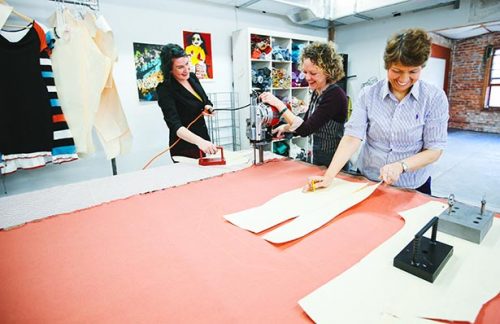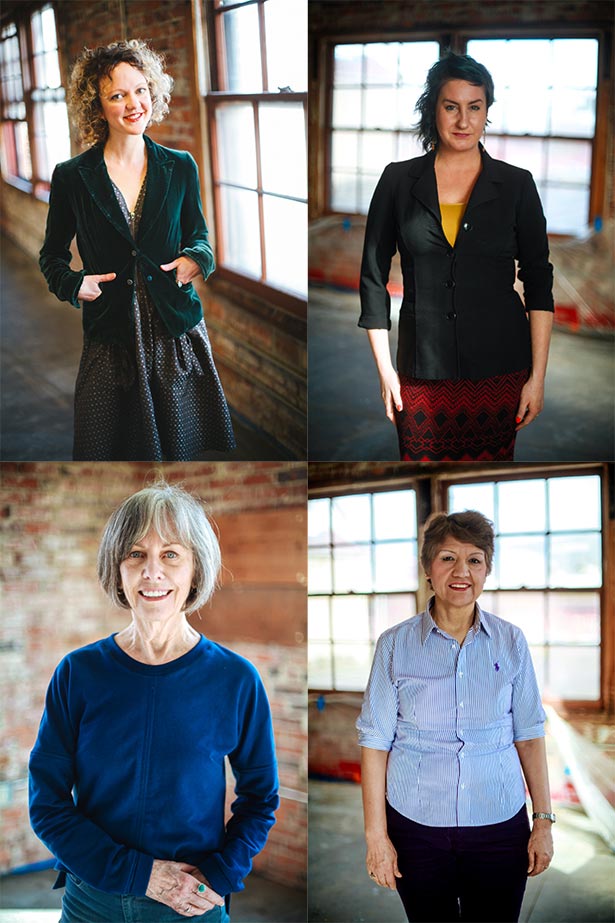
Three women sit in the back of The Redoux Parlour surrounded by piles of livestock feed bags, burlap sacks, scissors and sewing machines. Laura Lee Laroux, Grace McNabb and Irma Vega are deep in a product development session. Brainstorming how these raw materials can be transformed into popular products in the Eugene market, they pitch ideas like growler bags and grocery totes. Laroux creases the flap of a messenger-style pack made from the crinkly plastic of a Haystack Farm & Feed bag and throws the strap over her shoulder. The seams of the prototype, she points out to Vega, need tweaking and the straps should be longer. Otherwise, the trio appears happy with the bag — one of the first products of the Silver Lining Production House.
In the winter of 2012, EW reported on the growing need for a garment-manufacturing factory in Eugene (“Fashioning An Industry,” Dec. 6). With dozens of homegrown apparel and accessories designers in town but no local production house, the small industry was stagnating. Designers faced a problem: Product demand had exceeded what they could do with their own two hands but was not large enough to warrant contracting with a manufacturer overseas or in the remaining, however small, apparel production hubs of New York City or Los Angeles, which usually require orders starting in the thousands. According to an October article in IndustryWeek, the U.S. has lost 90 percent of apparel manufacturing jobs in the past two decades.
At that point, an indie apparel house, like the ones that have popped up in Portland in the past five years, was a long long-term aspiration. Less than 18 months later, however, that goal has been achieved. With local designer and entrepreneur Laroux at the helm, this unique group of women — a sort of perfect sartorial storm — opens Silver Lining Production House this month in the historic Lincoln Street Building at 4th and Lincoln. All it took was the right plan, the right team, the right space and a hell of a lot of elbow grease.
Strategy Style
“It’s about really helping designers get to what their next level is. A lot of the time, it’s starting in the production process,” says McNabb, who has been in partnership and product development meetings with Laroux and Vega for the past six months.
The production house is currently in the negotiation stage with five different regional clients. But more than sewing and manufacturing clothing for independent designers’ collections, Silver Lining will eventually be a multi-function fashion house. The founders plan to help designers with online sales, product photography, branding, sourcing materials and navigating trade and runway shows. As they contract with more clients, they will hire more production sewers and, further down the road, start a graphics department.
In a nutshell, they want to cultivate small fashion businesses. They hope these values come across in their union-inspired logo, which is currently in the design process.
“It symbolizes fair and equal work practices, which is one of the reasons we’re really doing this,” Laroux says.
“Made in America,” McNabb chimes in.
“I would love for our logo to basically say to people, ‘Trust in us. We’re going to care for your brand and your line as you care for your own and try to nurture the growth of it.’” Laroux continues, “A lot of our mission is to bump everything up to that next professional level in a way that allows the community and the country and the world to see what we’re doing here as legit and real and powerful and creative, and not just brush it to the side as some subgenre of hippie tie-dye clothes coming from Eugene.”
A year from now, they hope to see at least one client success story, with an independent designer’s clothing line manufactured, branded and selling in stores.
Common Threads
A Maryland native, Laura Lee Laroux studied design at the Fashion Institute of Technology in New York City at the turn of the 21st century. While going to school, she worked for a New York designer. “I would take out the trash and see so much fabric thrown away,” Laroux remembers. Those years in NYC ignited her lifelong passion for homegrown, sustainable fashion. After school, she came to Eugene via New Orleans, where she helped run a post-Katrina relief kitchen, making clothes from donated fabric and hand-me-downs on a donated sewing machine.
After settling in Eugene, Laroux worked at Infinity Mercantile, which she eventually bought and renamed The Redoux Parlour, a clothing store that sells local designs as well as secondhand apparel. The Redoux Parlour, which is currently transferring to its new ownership, is where she launched her line of sustainable prairie couture, Revivall Clothing — one of the first clients for Silver Lining. As a designer, Eugene Fashion Week producer and former storeowner (she is selling The Redoux Parlour), Laroux has long seen the need for a production house. With her dream in mind, Laroux needed help.
About a year ago, Grace McNabb responded to Laroux’s Facebook post looking for an assistant for Eugene Fashion Week. McNabb and Laroux recognized immediately that their working styles aligned, and they continued to collaborate on the Summer in the City and Whiteaker Block Party runway shows.
Besides their professional synergy, Laroux brought McNabb into the fold because of her fashion and marketing acumen in both Portland and Eugene.
“I was part of a fashion incubator that launched Portland Fashion Week 10 years ago,” McNabb says. McNabb originally joined the incubator as a jewelry designer (she still has her own line, Accents of Grace) and eventually became marketing co-chair of Portland Fashion Week for two years. Then a job opened up in Eugene for a product line manager for jewelry retailer Jody Coyote, now Oak Patch Gifts. “I came down and within the first week of working with them I was at a trade show in Hong Kong,” she says. After three years of doing international product development and national branding, the recession hit and McNabb was “laid off with accolades.” After a couple of years of stringing work together, McNabb saw the Facebook post and as of autumn 2013 became Laroux’s first official business partner.
Between the two of them, they fulfilled the design, marketing and product development aspects of the fashion business, but there were still some big gaps to fill. They needed someone with experience in large-scale apparel production. In walked Irma Vega, literally.
Vega first visited The Redoux Parlour in June of 2013 looking for designers who were willing to share fabric. “I saw the sign that they do alterations so I ask if they need sewers too. They say, ‘Yes.’ They ask me my experience that I have in sewing,” Vega recalls. “So I told [Grace] that I had my own business for 22 years and then she gave me Laura Lee’s information.”
Vega was born in Estado de Michoacán, Mexico, the daughter of a seamstress. At 19, following her parents, she moved to Los Angeles. Vega found work as a production sewer before starting her own business, with help from her then-boyfriend and future husband, sewing blouses in her father’s garage. It was the 1980s and “Made in America” was still a reality. They quickly outgrew the space and moved to a larger place in the San Fernando Valley, which became Irma’s Fashions. At its height, Irma’s Fashions was producing upward of 1,000 dresses a day. Vega managed anywhere from 60 to 75 employees at time, and in 1991, Irma’s Fashions pulled in $1 million in sales. The next year, Vega saw a shift in the industry.
“They started sending the products overseas, first to Mexico,” Vega says of her clients. “They want to pay us the same as Mexico. We tried to survive from ’92 to ’95.” Finally in 1997, Vega had to close her business for good. She moved to Eugene with her husband, who had family in town. Over the next 15 years, Vega pieced together work sewing for different local companies like Burley, Innovative Sports, Fleece and Beyond and Whitewater Designs. She even sewed dresses for dancers at the Silver Dollar Club.
After Vega communicated with The Redoux Parlor for a couple months, Laroux began pestering her to join the team for a garment production house. By October, Vega was on board as the third partner.
At this point, McNabb and Laroux were still attending meetings for the Eugene Garment Collective. The collective, whose members include local designers and sewers, has a longer-term plan to offer garment manufacturing, classes and membership. But the duo was itching to get started and the Eugene Garment Collective’s timeline was too far out. Then came a fateful week in October, a week McNabb and Laroux call the “turning-point week.”
“I dare you to take the reins,” McNabb recalls telling Laroux that week, trying to nudge her into a leadership role. “That was the week that Sue walked in the door.”
Enter retired commercial real estate broker and volunteer Sue Prichard. “Most of the volunteer work that I do is kind of related to land-use issues but this last fall I thought, you know, I want to get involved with something related to sewing,” says Prichard, who had been sewing as a hobby for decades. “So I Googled seamstresses in Eugene because I hadn’t really been involved in that sector very much and I came across [Laroux’s] blog … I read her whole blog and it was really touching and I thought, ‘I have to know this woman.’”
By November, Prichard was not only an investor and a mentor, but she was also helping produce the Silver Lining fundraiser show, “Launch,” at Territorial Vineyards. With a starting team in place, Silver Lining needed a home.
 |
| Clockwise: Laura Lee LaRoux, Grace McNabb, Irma Vega and Sue Prichard |
Lincoln Lining
On one of the first sunny March afternoons of 2014, Laroux, Vega and Prichard are working a pallet jack to move fabric cutting tables, shelving and other office furniture leftover from the previous tenant, QSL Print Communications. The second-floor 1,800-square-foot space on Lincoln fulfills many romantic notions of a creative warehouse space: exposed brick, high ceilings and good neighbors. As Laroux gives me a tour of the space, the train whistle blows from the tracks below their office window.
Silver Lining will share the floor with Peter Gribskov, the building’s owner, and FertiLab, a biotechnology “thinkubator.” Directly below them is Outsiders Craft Cider, a hard cider house also due to open this month, which is lined up next to the office and gallery space of Oregon Supported Living Program’s (OSLP) Arts & Culture Program. Arbor South Architecture sits on the north side of the first floor.
After reading the “Fashioning an Industry” story in Eugene Weekly, OSLP Executive Director Gretchen Dubie alerted Laroux about the space. Laroux and McNabb fell in love with it instantly. Under the mentorship of Prichard, they worked with real estate broker Christian Fox to secure the space. Silver Lining has a three-year lease in the Lincoln Street building.
“Because my career for the past 30 years has been commercial real estate, I’ve been in a lot of buildings like this and a lot of manufacturing facilities and I know what it takes to do something like this. I know it’s really hard. It’s expensive and it always costs more than you think it’s going to cost and it never happens exactly when you think it’s going to,” Prichard says.
But with the three partners investing their own funds, a loan, Prichard’s investment and money raised from the Territorial runway show, as well as a space to call their own, Silver Lining is ready for business.
“She’s starting out modestly, small, and that’s smart,” Prichard says of Laroux. “My prediction is they’ll grow out of this space.”
For more information, visit silverliningproduction.com. Look for part two of the fashion New Economy series later this year.